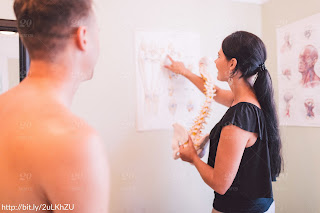If someone were to ask me
“what are the biggest influences on your therapy philosophy” they would be (in
no particular order)
·
Stuart McGill
·
The biopsychosocial approach popularized by
Lorimer Moseley, David Butler & Peter O’Sullivan
·
SFMA
·
Tim Gabbett
·
Good ol’ strength & conditioning (S&C)
·
And Robin McKenzie and the McKenzie Method (MDT)
During one of my clinical
placements I worked with several strict McKenzie therapists – including Richard
Rosedale who teaches many of the courses. Through the placement, and through
all of my jobs, I’ve been quite happy with the results I’ve gotten from MDT –
however I’d be lying if I said I didn’t need to adjust things along the way. 2
years ago I wrote an article
critiquing MDT which would become my 2nd most viewed article. The
focus of this article is to showcase how I’ve adapted the method, and my
principles, to better suit the needs of my clientele.
Disclaimer: I am writing this assuming that you have a
base knowledge of MDT. If you’re not reasonably familiar with the method I
recommend you take the time to do a course and/or read the books in order to
have a basic understanding of MDT. It’s more than just “chin tucks” or “sloppy
pushups” and should be understood for what it is, not the bastardized version.
With that out of the way – here are the modifications
I’ve used
1) Test non-painful directions first
The MDT therapists that I worked with in school taught me
to test the most painful and/or most restricted movement directions first to
see if a directional preference could be found that would improve symptomatic
or functional baselines.
However – I found that about 50% of patients would
benefit whereas the other 50% would be flared up … even more so for chronic
cases.
I got more bang for the buck testing non-painful
directions (where applicable) first. Then, if that didn’t produce any effect
and didn’t flare up symptoms, I would then proceed to look at other directions
of movement or positioning. I found by getting as much out of non-painful
movement as possible that patients adhered to exercises better and got better
results.
2) (For more irritable clients) Only test 1-3 “symptom
modifiers” per session
As such – I recommend testing no more than 2 or 3 symptom
modifiers, whether that’s different positions and/or repeated movements in a
direction, in a session. If it ain’t working it ain’t working. Don’t beat them
up physically or psychologically.
3) (For more irritable clients with spinal pain) Test positions
first – then work your way up
Even though MDT is predominantly associated with neck
& low back pain (even though it can be applied to all joints) I never got
what I wanted out of it with respect to spinal pain – particularly with neck
pain.
Many people I see with spinal pain in my current job are
more chronic & globally sensitized cases that have constant pain that’s
aggravated by every position & movement. Many of the chronic, insidious
onset neck pain cases tend to follow suit.
For these more irritable cases I usually just test static
positions first (i.e. lying/sitting in a more flexed or extended position) to
see if that provides some symptomatic relief or functional improvement – and
then go from there. I’ve found many do find a position that finds relief but
don’t necessarily tolerate repeated spinal movements in any direction.
4) Use it within a comprehensive approach
My second big knock against MDT, other than the ability
to potentially flare patients up, is that it could be more comprehensive. What
does this mean? Breaking it down by area I like to also look at
·
Psychosocial factors & beliefs: which MDT
does and was way ahead of its time on
·
Endurance, strength & control of the
affected area & other joints
·
Workload management: this is where Tim Gabbett’s
stuff comes in
·
General lifestyle factors like sleep &
bodyweight management
Repeated knee flexions may temporarily improve a person’s
pain or their ability to do stairs – but if they’re running way more than they
have in the past & flaring up their symptoms with it than you may not get
far. Your client with discogenic back pain and a directional preference to
lumbar extension may not make much progress if their hips & ankles are so
stiff that they have to flex their spine excessively anytime they bend over.
If you have a directional preference that’s great – but
if any of these other factors are heavily contributing to an individual’s
sensitivity then they need to be addressed to allow for optimal recovery.
5) Know when to bail
Sometimes clients don’t have a directional preference to
repeated movements or positions and/or it just flares them up everywhere.
Sometimes those aren’t right for everyone and then patients have to be shifted
to, and treated appropriately, within the “other” categories (refer to the
books and courses for more detail on those).
MDT can be a useful part of a comprehensive therapy
program – but it does need to be adapted to the individual. I hope this article
provides some insight into how I adapt the method. As always – thanks for
reading.











